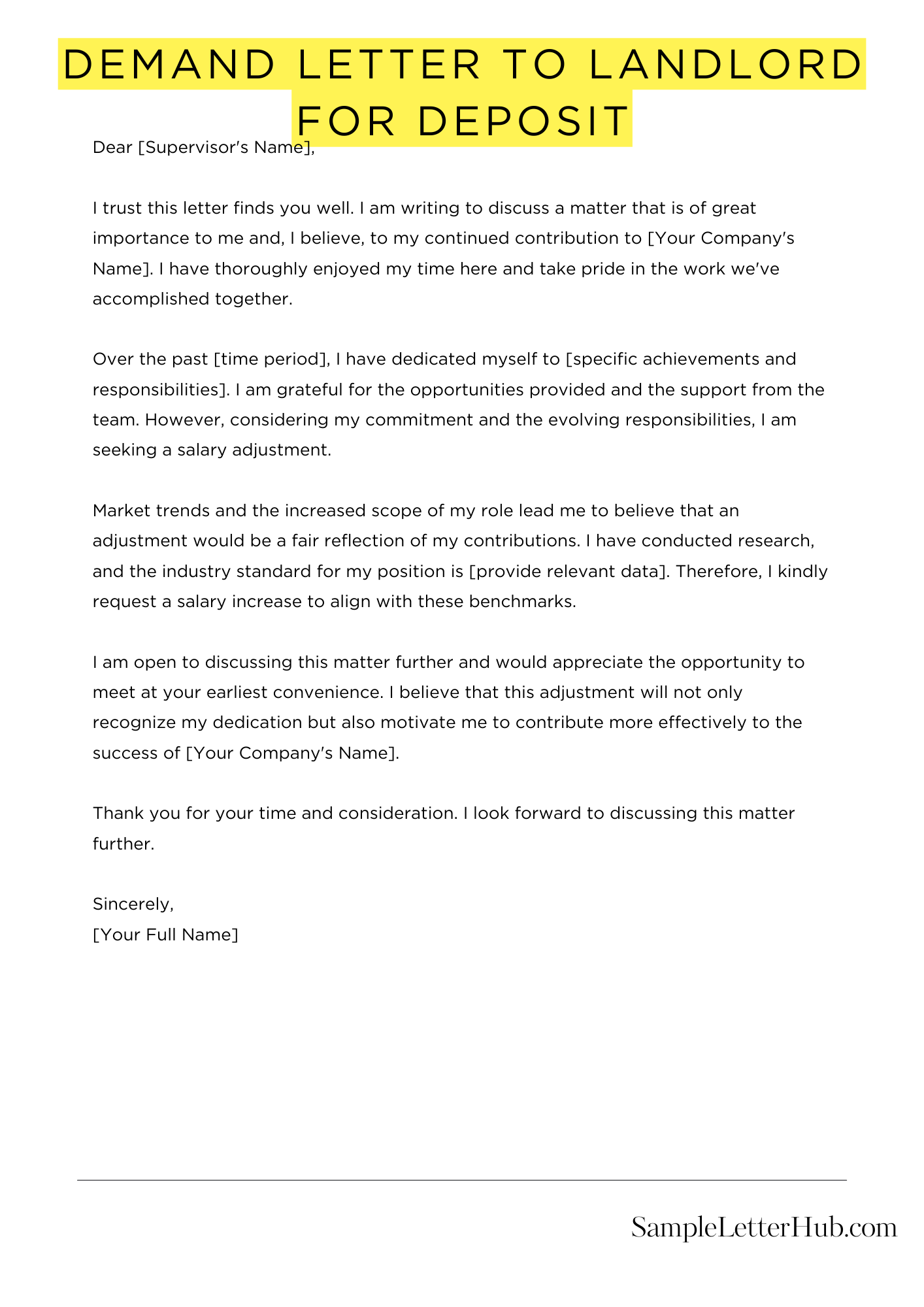A demand letter to a landlord for deposit is a formal request in writing to your landlord demanding the return of your security deposit. It is a crucial step in the process of getting your deposit back after you move out of a rental property.
In this blog article, we will provide you with several templates, examples, and samples of demand letters to landlords for deposits. These templates will help you draft a well-written and effective demand letter that will increase your chances of getting your deposit back in full.
Demand Letter To Landlord For Deposit
Dear [Landlord’s Name],
I am writing to demand the return of my security deposit for the property located at [Property Address], which I vacated on [Move-Out Date].
As per our lease agreement, I paid a security deposit of [Deposit Amount] on [Deposit Date]. I have fulfilled all my obligations as a tenant, including paying rent on time and leaving the property in good condition.
I have made several attempts to contact you regarding the return of my deposit, but I have not received a response. I am entitled to the full refund of my deposit within [Number] days of vacating the property.
I request that you return my security deposit in the amount of [Deposit Amount] to me within [Number] days of receipt of this letter. I am available to meet with you at your earliest convenience to collect the deposit.
If you fail to return my deposit within the specified timeframe, I will have no choice but to pursue legal action to recover it.
Thank you for your attention to this matter.
Sincerely,
[Your Name]

How to Write a Demand Letter to Landlord for Deposit
Writing a demand letter to your landlord for your deposit can be a daunting task, but it doesn’t have to be. By following these simple steps, you can ensure that your letter is clear, concise, and persuasive.
Step 1: Gather Your Evidence
Before you write your letter, it’s important to gather all of the evidence that supports your claim. This may include your lease agreement, receipts for any cleaning or repairs you’ve made, and photos of the property’s condition when you moved out.
Step 2: State Your Claim
The first paragraph of your letter should state your claim clearly and concisely. For example, you could write, “I am writing to request the return of my security deposit in the amount of $1,000. I moved out of the property located at 123 Main Street on [date].
Step 3: Provide Supporting Evidence
The next paragraph of your letter should provide supporting evidence for your claim. This could include references to your lease agreement, receipts for any cleaning or repairs you’ve made, and photos of the property’s condition when you moved out.
Step 4: State Your Deadline
The final paragraph of your letter should state your deadline for the landlord to return your deposit. For example, you could write, “I request that you return my deposit within 30 days of the date of this letter.
Step 5: Be Polite and Professional
Even though you’re writing a demand letter, it’s important to be polite and professional. This will increase the chances of your landlord responding positively to your request.
Step 6: Keep a Copy
Once you’ve written your letter, make sure to keep a copy for your records. This will come in handy if you need to follow up with your landlord or take legal action.
Step 7: Get Help if Needed
If you’re having trouble writing a demand letter to your landlord, there are a number of resources available to help you. You can contact your local tenant’s rights organization or consult with an attorney.
FAQs about Demand Letter To Landlord For Deposit
What is a demand letter for a deposit?
A demand letter for a deposit is a formal letter sent by a tenant to their landlord requesting the return of their security deposit. It typically includes details about the tenancy, the amount of the deposit, and the date by which the tenant expects the deposit to be returned.
When should I send a demand letter for my deposit?
You should send a demand letter for your deposit within a reasonable time after the end of your tenancy. In most states, the landlord has 30 days to return the deposit, but it’s best to send the letter as soon as possible to avoid any delays.
What should I include in a demand letter for my deposit?
Your demand letter should include the following information:
- Your name and contact information
- Your landlord’s name and contact information
- The address of the rental property
- The dates of your tenancy
- The amount of your deposit
- The date by which you expect the deposit to be returned
- A statement that you have cleaned the property and left it in good condition
What should I do if my landlord does not return my deposit?
If your landlord does not return your deposit within the time frame specified in your demand letter, you may need to take legal action. You can file a small claims lawsuit or hire an attorney to help you recover your deposit.
Can I get interest on my security deposit?
In some states, landlords are required to pay interest on security deposits. The amount of interest varies from state to state, but it is typically a small percentage of the deposit amount. You can check your state’s laws to see if you are entitled to interest on your security deposit.

